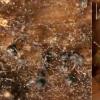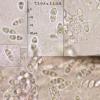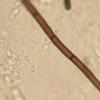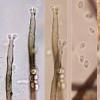
09-12-2025 12:06
 Andgelo Mombert
Andgelo Mombert
Bonjour,Je recherche l'article concernant Hypobryo

07-12-2025 16:07
Arnold BüschlenHallo, ich habe in einer Moos-Aufsammlung (epiphy

08-12-2025 21:04
Mark Stevens"Hello everyone,I'm relatively new to microscopy (

08-12-2025 18:59
 Lothar Krieglsteiner
Lothar Krieglsteiner
.. found by a seminar-participant, I do not know t

08-12-2025 17:37
 Lothar Krieglsteiner
Lothar Krieglsteiner
20.6.25, on branch of Abies infected and thickened

16-03-2014 22:00
Hello,I found this species a few months ago but ha

08-12-2025 13:39
Thomas Læssøehttps://svampe.databasen.org/observations/10572899
Chaetosphaeria on Quercus
Enrique Rubio,
26-11-2012 17:39
We have collected these small (up to 0.15 mm), gregarious, black, superficial, globose and hairy perithecia on Quercus wood.
The prithecia grew among conidiomata of a dematiaceous mould and their ascospores breaking into equal-sized part-spores of 7-9 x 3-4 microns.
Could this fungus be Chaetosphaeria vermicularioides or Ch. preussii? Can these conidiomata belong to the anamorphic state?
Many thanks for your help
Alain GARDIENNET,
27-11-2012 08:54
Re : Chaetosphaeria on Quercus
Hi Enrique,
You are near to the solution.
It seems to be a Chloridium anamorph.
Can you give exactly the size of ascospores or ascospores part if it's really fragmented (is it ?) and conidiospores. Your fungus is probably in the group : preussi/vermicularioides/myriocarpa/lentomita/barbicincta.
Have you Reblova's paper ?
Amitiés,
Alain
You are near to the solution.
It seems to be a Chloridium anamorph.
Can you give exactly the size of ascospores or ascospores part if it's really fragmented (is it ?) and conidiospores. Your fungus is probably in the group : preussi/vermicularioides/myriocarpa/lentomita/barbicincta.
Have you Reblova's paper ?
Amitiés,
Alain
Jacques Fournier,
27-11-2012 09:25

Re : Chaetosphaeria on Quercus
Hola Enrique,
d'accord avec toi et Alain. Je pense que C. vermicularioides est l'espèce qui correspond le mieux à ta récolte à cause de la conidiogenèse multiple que l'on voit bien sur ta photo de la collerette terminale. La largeur des spores correspond aussi mieux qu'à C. preussii.
Malheureusement je ne connais pas bien ces espèces et un avis plus compétent serait le bienvenu.
Amitiés,
Jacques
d'accord avec toi et Alain. Je pense que C. vermicularioides est l'espèce qui correspond le mieux à ta récolte à cause de la conidiogenèse multiple que l'on voit bien sur ta photo de la collerette terminale. La largeur des spores correspond aussi mieux qu'à C. preussii.
Malheureusement je ne connais pas bien ces espèces et un avis plus compétent serait le bienvenu.
Amitiés,
Jacques
Enrique Rubio,
27-11-2012 19:51
Re : Chaetosphaeria on Quercus
Hi Alain and Jacques
The ascospores are fully disarticulate at maturity and the part-spores reaching 3.5-4.7 x 2.7-3.7 microns.
The conidia are 4.6-5.4 x 2.7-2.8 microns.
No. I have not Reblova´s paper
Many thanks to both
The ascospores are fully disarticulate at maturity and the part-spores reaching 3.5-4.7 x 2.7-3.7 microns.
The conidia are 4.6-5.4 x 2.7-2.8 microns.
No. I have not Reblova´s paper
Many thanks to both
Alain GARDIENNET,
27-11-2012 20:08
Re : Chaetosphaeria on Quercus
Ce papier est dans le SIM 45 mais je te l'envoie dans ta boîte.
Alain
Alain




